|
Mar
18
2024
|
|
Posted 1 years 279 days ago ago by Admin
|
|
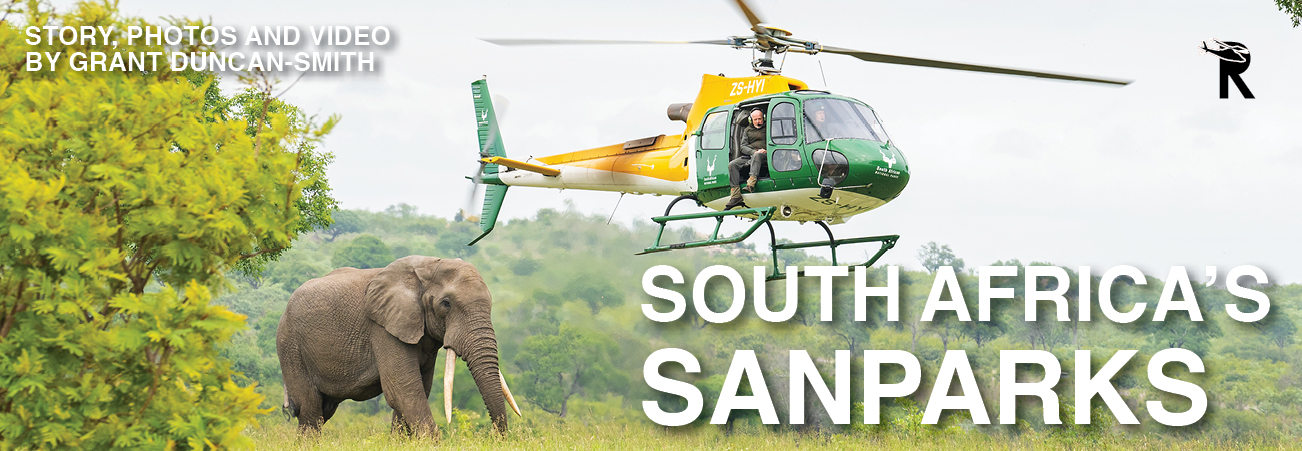
VIEW VIDEO
It is a vast untamed wilderness where lions, rhinos, elephants and other wild animals roam freely, but the massive park’s borders are sometimes breached by a network of highly skilled and motivated poachers. High temperatures often reach north of 110o (F) in the summer months. These are some of the formidable challenges that the South African National Parks (SANParks) Air Services has to navigate.
The Kruger National Park borders Mozambique on the eastern side and Zimbabwe on the northern side. SANParks Air Services provides the aerial support required for over 2 million hectares, as well as the other 19 parks of SANParks across South Africa. Poachers are a huge problem, although the battle is slowly being won, and rhino poaching has stabilized and reduced over the past years.
Despite back-breaking work from a dedicated and passionate SANParks team, Kruger National Park rhino populations have continued to plummet due to rhino poaching (according to the population count from 2020). Recently published research estimates that there are about 2,607 white rhinos remaining in the Kruger National Park, while black rhinos are estimated to number just 202. This represents a population decline of 75% for white rhinos since 2011 (from 10,621) and 51% for black rhino since 2013 (from 415).
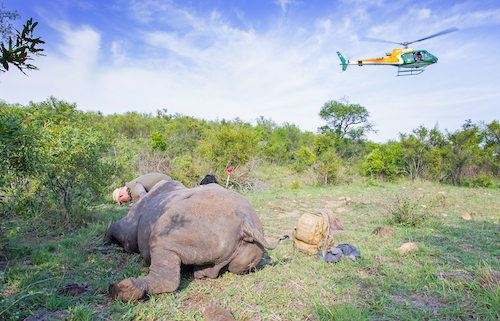
"Recent trends in rhino poaching show a move away from the Kruger National Park to private reserves and KwaZulu-Natal (the garden province)" said Barbara Creecy, minister of forestry, fisheries and the environment.
In recent years, the work of rangers has changed from a general focus on the conservation of species to a more militant way of operating against well-armed criminal poaching gangs entering national parks and other conservation areas. Rangers often spend weeks away from home, living in the bush in an effort to protect the country's natural environment from plunder.
A global money laundering and terrorist financing watchdog, the Financial Action Task Force (FATF), completed an assessment in 2019 of the threats posed to South Africa, and the effort being made to fight these crimes. During this process, the contribution of wildlife trafficking was found to pose a medium-to-high risk to the country.
The air wing has three Airbus H125 helicopters and four pilots based in the Kruger National Park. They hope to increase to four helicopters in the near future.
‘’The Airbus H125 or Squirrel, is respected around the world after decades of proven ability. The H125 (previously designated the AS350 B3e) outclasses all other single-engine helicopters for performance, versatility, low maintenance, and low acquisition costs, while also excelling in high-and-hot extreme environments. It is a member of Airbus’ Ecureuil family, which has accumulated 38 million flight hours worldwide.
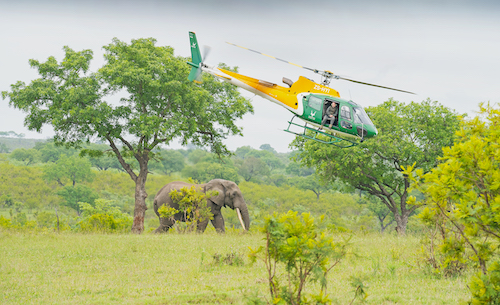
The H125-series helicopters have broken world records throughout their career. In 2005, the AS350 B3 set the world record for the highest altitude landing and takeoff, performed on Mount Everest at 29,029 feet (8,848 meters) – a title still held today. In May 2013, the AS350 B3 performed the world's highest long-line rescue operation on Lhotse, the world's fourth-highest mountain, located in the Himalayas at 25,590 feet (7,800 meters).
With built-in maneuverability, excellent visibility and low vibration levels in the cabin, the H125 has earned its reputation as a true multi-mission workhorse. The versatility of the H125 is evident. Flying operations are dynamic, with each day providing different challenges. The H125 thrives in this environment – from slinging equipment to mountain tops, darting elephants, rhino dehorning, having dogs on-board, VIP flights to airborne surveillance. The ease in which the cabin can be reconfigured for these varied operations assists in the efficiency and flexibility of the operations, and the value that the Airbus H125 delivers. The flat floor assists in sliding equipment in and out, and the sliding doors on both sides of the helicopter can also be opened during flight under certain speeds. Having enough power when flying slow and low, at high altitude with a full crew and passengers is appreciated by the team. Tranquilizer darting operations are dynamic, with the animals moving unpredictably. Trees, power lines and other obstructions need to be monitored and navigated.
Between the months of August and September, 450 - 500 hours of census flying are completed by the SANParks teams where they fly through the Kruger National Park, making sure they have the correct population of rhinos and elephants..
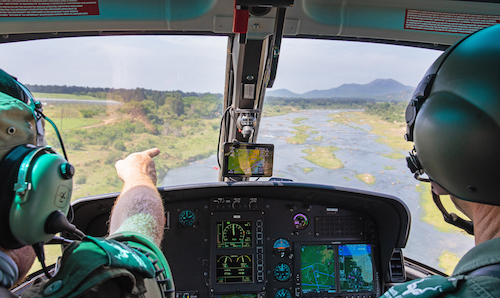
I joined the SANParks Air Services for a few days of operations. Landing at the airport, there is a brief respite from the heat with some welcome rain. I joined the team to plan the next few days’ operations. The following day starts early at 05:00 a.m. After a quick coffee, the helicopters are moved outside onto the ramp and a pre-flight inspection is completed. The SANParks veterinary wildlife services vets join us at 05:15 and prep their gear such as harnesses, medication and dart guns. We are focused on two days of elephant management. The days start early to avoid the coming heat.
There is a slight chill in the air as we take off. Support from various fixed-wing aircraft helps to locate certain animals via GPS coordinates. After about 15 minutes of flying to their location, we scour the bushveld for elephants. Ground crews are in radio contact with us to coordinate the operation. The idea is to locate the animals from the air and direct them with the helicopter to a relatively open area clear of vegetation so the vet can dart the elephant. After about 10 minutes, an elephant is sedated, and the groundcrews move in. Various health checks are completed and samples taken to detect diseases such as tuberculosis. The ground crew consists of various nationalities: American, German and Swiss, all working as part of their foundations or universities. They have the common goal to promote the health and wellbeing of the elephant and rhino populations, and it’s clear that they are deeply passionate about their jobs.
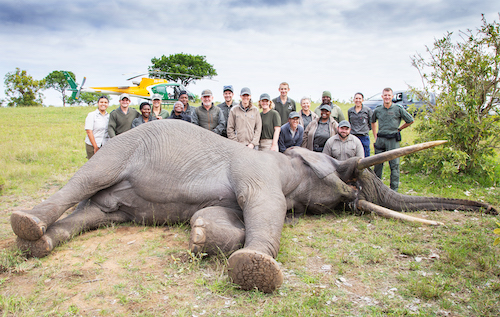
Each member of the team has a special calling to their job. They are, without fail, passionate, committed, energetic and humble. I’ve witnessed tough anti-poaching rangers being close to tears because of a rhino dying, and seen the urgency and emotion on a pilots’ face when an elephant with a snare around its foot was struggling to cross a river. These guys feel the pain of animals, and are deeply committed to their well-being.
Pilot ability and temperament are essential in these challenging flying environments. There is no room for show-boating, bravado, or taking unnecessary risks. All of the pilots have a calm demeanor and personality. When there is urgency, they move quickly. When they need to slow things down, they do. One of the pilots, Brad, always checks with each crewmember by name to see if they are happy and ready for takeoff. When the vet is darting, or getting in or out of the helicopter, Brad is always communicating to learn whether the vet is securely harnessed in and happy. It’s easy to become relaxed and overly comfortable, and it only requires one mistake for tragedy to occur.
Everyone pitches in where they can, even when it isn’t part of their immediate job. The vet lends an additional pair of eyes on landing, to ensure the tail-rotor is clear from surrounding obstacles. The pilot helps to carry gear and assists with rhino-horn removal.
This multi-disciplined approach involving all participants acting consistently over a long period has started to pay dividends. Each aspect, from the funding and sponsors, the vets, ground-crews, rangers, tracking dogs and handlers, helicopter and fixed-wing pilots, are all crucial to the SANParks Air Services’ success.
The consistency of having three of the same type of helicopter is vital. From a maintenance perspective, the knowledge base of working on these helicopters and worldwide maintenance support is invaluable. From the pilots’ side, flying the same helicopter type day after day provides stability, trust in the machine and consistency. These aspects are essential when flying in challenging environments such as Kruger National Park.
With a professional and dedicated SANParks Air Services and support team, I have no doubt that the Kruger National Park is in good hands.
VIEW VIDEO READ MORE ROTOR PRO: https://justhelicopters.com/Magazine
WATCH ROTOR PRO YOUTUBE CHANNEL: https://buff.ly/3Md0T3y
You can also find us on
Instagram - https://www.instagram.com/rotorpro1
Facebook - https://www.facebook.com/rotorpro1
Twitter - https://twitter.com/justhelicopters